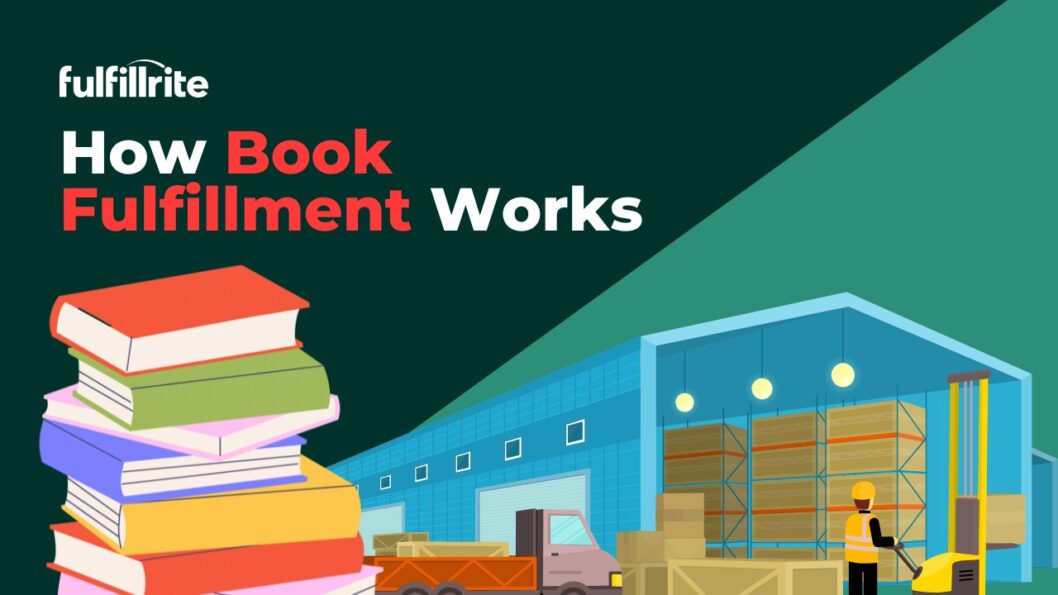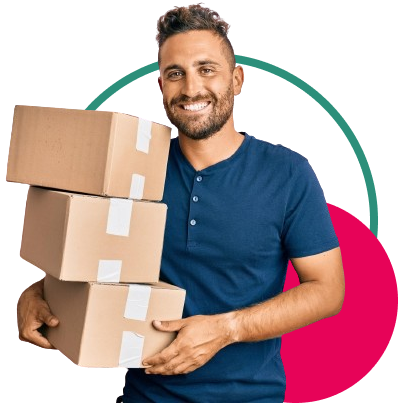Your book is finished. Now you have to get it into someone’s hands.
You wrote the book. You found a printer. You paid for a stack of boxes filled with your words.
Now what?
For most self-publishers, this is the moment the panic sets in. Because finishing the book is one thing. Shipping it without wrecking your life is something else entirely.
That’s where book fulfillment comes in.
Book fulfillment isn’t glamorous. It’s not the part you post about on social media. But it’s the part that determines whether your customer gets a pristine copy in three days—or a bent mess in two weeks.
It’s not just shipping. It’s not just boxes. It’s the invisible backbone of a real book business.
So if you’re planning a launch, running a Kickstarter, or growing a direct-to-reader storefront, this is the part that needs to work smoothly.
In this post, we’re going to explain what book fulfillment services are, what they include, and how to choose a partner that won’t let you down.
Let’s start with the basics.
1. What is book fulfillment?
Book fulfillment is everything that happens after the printer finishes your book. Of course, this is a very simple definition that belies a very complicated series of processes.
Book fulfillment means receiving inventory, storing it, picking and packing each order, printing shipping labels, handling returns, and keeping track of what’s selling.
It’s the boring stuff. The hard stuff. The make-or-break stuff.
Here’s a simple example.
You print 2,000 copies. Great. But who ships them?
Who stores them so they don’t get warped or moldy? Who finds the right one when someone orders from your website? Who adds the signed bookplate and bookmark, tapes up the box, and gets it out the door the same day?
That’s book fulfillment. It’s not printing. And it’s not something print-on-demand handles well at scale.
Some services combine printing and fulfillment under one roof. Others leave fulfillment entirely up to you. Either way, if you want to control quality and costs, and keep some sanity in the process, you need to understand the difference.
Book fulfillment vs. book printing
Printing makes the book. Fulfillment delivers the book to your customer.
Printing ends at the loading dock. Fulfillment begins the moment someone clicks “Buy.”
And while some authors try to manage all of this from a garage, that only works for a while. The more orders you get, the faster the system falls apart.
A dedicated book fulfillment center takes this work off your plate. They store your books, and pack and ship them when they need to go out to your readers.
This is what Fulfillrite does, day in, day out. But we’ll get to that later.
What Book Fulfillment Services Actually Do & Why It’s Not Just Shipping
If you think book fulfillment just means slapping on postage, think again.
A good book fulfillment partner doesn’t just ship boxes. They run the invisible parts of your business—quietly, consistently, and without screwing up your launch.
Most first-time authors don’t think about this until too late. They’ve got a couple hundred preorders, a pile of books in the hallway, and a vague plan involving a tape gun and a lot of coffee. It works. Sort of. Until it doesn’t.
If you’re serious about getting books to readers on time, and in one piece, you need to know what book fulfillment services really involve.
What do book fulfillment services include?
There’s a lot more happening behind the scenes than most people realize. Here’s what a professional book fulfillment center actually does:
1. Receiving inventory
Your printer ships a few pallets of books. They don’t just get tossed on a shelf.
A fulfillment center checks for damage, logs what’s received, and adds it to your inventory system. If something’s missing or busted, they’ll flag it before it becomes your customer’s problem.
2. Warehousing (with climate control)
Books warp. Paper absorbs moisture. Covers curl.
If you’re storing your inventory in a basement, attic, or storage unit, you’re playing with fire. Good fulfillment centers store your books in clean, climate-controlled environments. Temperature, humidity, and dust are all kept in check.
3. Pick and pack
An order comes in. Someone has to go find the right book (or books), grab any extras, and pack them securely.
This isn’t one-size-fits-all. Some books need padded mailers. Others need boxes. Some bundles need tissue wrap and inserts. Some come with postcards or signed bookplates.
It’s not just about speed. It’s about packing right and thereby preventing bent spines and dinged corners.
4. Shipping and tracking
Once packed, the label gets printed and the order goes out—same-day for many fulfillment partners, ourselves included. Tracking gets sent automatically.
Customers desires, when it comes to shipping, are pretty straightforward. They want to know where their stuff is. And if something goes wrong, they want a fix fast.
5. Returns handling
Returns happen. Wrong address. Damaged in transit. Customer changed their mind. These kinds of issues are unavoidable, at least to some degree.
A proper fulfillment service takes returns seriously. They process them, restock usable items, and notify you if anything looks off. You don’t get stuck doing damage control.
6. Optional: kitting, international shipping, DDP
Got a bundle? A box set? Bonus merch?
Need to ship to readers in Europe or Canada?
Good fulfillment services can:
- Combine multiple items into one shipment (kitting)
- Prep international orders with customs-compliant paperwork
- Offer Delivered Duty Paid (DDP) to avoid surprise fees for customers
This is where “book fulfillment and distribution” really shows its value. It’s not just U.S. shipping that matters, but having a way to reach people around the world too.
Book fulfillment is infrastructure, not luxury.
If your launch, store, or campaign depends on happy customers, you need a fulfillment plan you can count on.
Fulfillrite offers all of the above—plus real-time dashboards, transparent pricing, and integration with Shopify, Kickstarter, WooCommerce, and more. No surprises. No nonsense.
But whether you use us or someone else, the services listed here aren’t extras. They’re the bare minimum if you want to deliver books at scale without losing all your time to write the sequel!
Things to Consider When Choosing a Reliable Book Fulfillment Partner
Self-publishers don’t ship like big publishers. So why use a service built for them?
If you’re running a small press or putting out your own book, you’re not sending 10,000 copies to a warehouse once a quarter. You’re sending 200 orders in the first two days of your launch. You’re shipping to backers across five continents. You’ve got bookplates, signed editions, preorders, press copies, and stretch goal merch that showed up two days late.
The logistics are messy. But readers don’t care. They expect clean, fast, accurate shipping, just like they’re ordering from Amazon.
So if you’re looking into book fulfillment services, you need one that’s built to handle the chaos that comes with being a self-publisher.
Fulfillment for self-publishers: special challenges
Self-publishing is full of edge cases. No one’s going to hand you a process map. You make it up as you go, and that includes fulfillment.
Here’s what makes self-publishing logistics uniquely painful:
Tight launch dates
You don’t have a rolling release schedule. You have one day when every preorder needs to go out. Late shipments mean bad reviews, angry emails, and missed media coverage.
Complex bundles
It’s not just the book. It’s the signed book. The bonus short story. The enamel pin. The postcard with custom art. All of it has to arrive together, packed right, and in the right box.
This isn’t just a packing job. It’s attention to detail: something generic book 3PLs (third-party logistics companies) often miss.
Small order volume, high stakes
You’re not moving thousands of units per week. But every order matters. If someone gets the wrong edition, or a dented cover, or no tracking number, you’ve lost that reader—and maybe a few more.
You need a partner that doesn’t treat “small” like “unimportant.”
Storage space is limited (or nonexistent)
Your garage, office, or hallway isn’t a long-term warehouse. You need a place to store books that won’t warp in the summer or freeze in the winter. And you need to be able to track what’s where and without digging through boxes.
Fulfillrite offers clean, climate-controlled storage and a real-time dashboard, so you always know what’s in stock, what’s shipping, and what’s running low.
So how do you choose the right fulfillment partner?
Here’s how to evaluate a fulfillment partner without getting overwhelmed or falling for the wrong pitch.
1. Look for eCommerce integration
If you’re selling on Shopify, WooCommerce, Etsy, Kickstarter, or even Amazon FBM, your fulfillment center should plug in directly. Orders should flow automatically. No copy/pasting. No spreadsheets. No manual errors.
2. Ask about packaging standards
Books are fragile. If your fulfillment partner is tossing paperbacks into loose mailers with no support, you’ll be the one issuing refunds.
Ask for details: Do they use stiffeners? Bubble wrap? Branded packaging? What’s their damage rate?
3. Watch for hidden fees
Some fulfillment companies lure you in with cheap base rates, then nickel-and-dime you for packing materials, storage, bundling, or returns.
Ask for a full pricing breakdown. Understand what’s included. If something looks too good to be true, it probably is.
4. Make sure support is human and responsive
Can you talk to a real person? Will they answer the phone if your inventory gets delayed in transit? Do you get a dedicated contact, or are you stuck in a ticketing system?
You don’t need the biggest fulfillment company. You need the right one—the one that knows your business, supports your goals, and doesn’t make you dread every new order.
Printing + fulfillment: when to combine (and when not to)
Some companies offer both printing and fulfillment in one. This can be really efficient, but isn’t always the right choice for everyone. Here’s how you can make a decision on what’s right for you.
When combined services work:
- You’re testing a concept or running a short-term promotion
- You’re using print-on-demand (e.g. Amazon KDP or IngramSpark) and don’t care about margin
- You’re okay with basic packaging and slower international delivery
When to keep them separate:
- You’re running a major launch, Kickstarter, or preorder campaign
- You need branding, bundling, or advanced packaging
- You want to print in bulk to save cost, then ship efficiently
- You care about presentation and reliability
Ideal setup: Work with a reliable printer for production and a dedicated book fulfillment center like Fulfillrite for logistics. That way, you control quality and cost—without giving up flexibility.
Final Thoughts
You can have the best story in the world. Beautiful design. Flawless editing. Glowing blurbs. But if it shows up late, damaged, or missing a signed insert… all that hard work disappears in a puff of reader frustration.
Book fulfillment is where your professionalism shows—or doesn’t.
A good partner helps you deliver what you promised. They don’t make you babysit shipments. They don’t lose books or confuse addresses. They just quietly get the job done, so you can keep doing yours.
If you’re ready to stop packing boxes and start shipping like a pro, Fulfillrite is here to help. We specialize in book fulfillment for self-publishers, small presses, and crowdfunded campaigns—fast, careful, and reliable.

